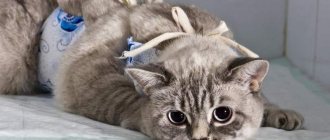Cats have a sexual cycle, which includes a period of estrus. At the same time, the animal experiences hormonal changes, due to which a change in behavior occurs - the pet becomes aggressive, restless and excitable, in addition, external signs of preparation for fertilization appear - secretion leaking out of the loop, swelling and redness of the external genitalia. If you do not plan to breed the animal, you can resort to sterilization, but not during estrus, but in the middle of the cycle. Sterilization during estrus is not recommended by experts.
Optimal age for intervention
Animal lovers often wonder whether it is possible to sterilize a cat while walking. It's best to do this as early as possible. For example, recommended age:
- 8 months;
- 10 months;
- 1 year;
- 1.5 years.
Babies easily tolerate sterilization, complications are rare
By completing the procedure at eight months, the owner is guaranteed to solve the problem of unwanted pregnancy once and for all. However, animal owners are often afraid that too early intervention can harm the fragile body. These fears are unfounded. If the cat is healthy, no problems should arise. The main thing is to follow all the recommendations of the attending veterinarian.
Important! Difficult childbirth is much more dangerous for a young female.
The younger the animal, the easier it will tolerate the effects of anesthesia.
To be or not to be offspring?
The owner of a grown-up cat recently began to complain: “How can you not go crazy, get enough sleep at night and not harm your pet?”
These three questions in one force cat owners to look for answers on the websites and forums of breeders and veterinarians.
Discussions on social networks recommend that the owner decide on the main question: whether to get children from his pet or whether kittens are not included in the family’s life plans. There is no third option.
Felinologists advise sterilizing an animal if:
- there is no desire, time and opportunity to breed cat offspring;
- The cat is not suitable for breeding work.
After all, after sterilization, the mental health of the furry beauty will be fine, and the age-related risk of oncology of the reproductive system will be reduced to zero.
Signs of estrus
To attract males, females use 2 tools: voice and smells. All sounds made become rougher and louder. Frequent but light urination occurs not only in the litter box - the pet leaves odorous marks on vertical and horizontal surfaces. Raising her tail and turning her back towards the target, she secretes a few drops of urine.
Another way to place marks is by rubbing them on objects. The glands on the cheeks of furry pets secrete a special secretion, allowing them to leave an individual scent.
The signs of the first menstruation are identical to subsequent ones. They are distinguished only by their weak expression in young animals.
Remember that discharge during “critical days” should be transparent. The appearance of blood or pink clots is a dangerous symptom that requires diagnosis.
Are anti-estrus drops and pills safer than injections?
Many owners believe that the oral use of hormonal drugs to suppress estrus significantly reduces the risk of side effects and complications. This is wrong. The composition of such drugs most often includes mepregenol acetate and ethinyl estradiol, which block the production of sex hormones and change the biological properties of the vaginal environment. They are used to interrupt (delay) estrus, to prevent unwanted pregnancy, and even as sedatives before a trip.
But manufacturers do not indicate all the side effects in the instructions, and they are absolutely the same as those of injectable drugs. Therefore, you should not treat this category of drugs as a panacea.
How is sterilization different from castration?
The standard procedure for removing the uterus is carried out in all veterinary clinics. Proper preparation reduces all risks to a minimum. It is recommended to begin preparations at least two weeks before the intended sterilization.
To properly prepare your pet for medical intervention, you must:
- take blood tests;
- take a general urine test;
- undergo an examination by a cardiologist and do an ECG (especially if the animal is 7-8 years old);
- do an ultrasound (according to indications).
If any abnormalities are detected, the operation will be delayed.
Attention! Before carrying out the manipulation, it is necessary to carry out unscheduled treatment against worms and vaccination against rabies. Data about these procedures are entered into the animal’s veterinary passport. Without this information, the cat may not be allowed on the operating table.
Technique
You can castrate a female in the first two days after the start of estrus. An incision is made in the animal's abdominal cavity, the uterus is excised and removed, and then stitches are applied. After this manipulation, the cat will need to wear a blanket for a long time to prevent infection of the stitches.
After sterilization, the owner’s main task is to provide the cat with peace and not let it go outside. Also, the animal should be protected from sudden changes in temperature and fed moderately, because heavy food can cause vomiting.
After surgery, your pet may feel chills or nausea
Attention! After surgery, the animal may behave aggressively or, conversely, lethargically. This is how the delayed effect of anesthesia manifests itself. There is no need to worry - this phenomenon passes quickly.
We suggest you read: If you are bitten by a rabid cat: symptoms and signs of rabies in a person after being bitten by a cat or cat, is there a rabies vaccine for people
Removing a cat's uterus surgically has many benefits, such as:
- protection from unwanted offspring;
- increasing the life expectancy of the animal;
- improving the cat's character;
- normalization of hormonal levels.
But most importantly, the cat will begin to behave calmer and will not ask to go for a walk. This is especially important for owners who keep pets in large cities, where pets cannot be left unattended for a long time.
In order for the animal to safely undergo castration, the cat must be properly prepared for medical intervention. This will help avoid serious postoperative complications and psychological stress. If everything went well, the cat needs a good gentle regimen for at least a month. Then she will quickly regain her physical strength and finally recover.
During surgical sterilization, obstruction of the tubes leading from the ovaries to the uterus is created. The sperm will not meet the egg and fertilization will not occur. Of course, in this case there will be no more kittens and there is no need to worry about accidental matings. But sexual attraction remains.
If there is no fertilization in the cat, estrus will begin again after 2 weeks or an imaginary pregnancy will develop, which can easily be confused with the real one. An attempt to deceive nature most often ends in hormonal imbalances, giving rise to a tumor process.
Castration is the removal of the ovaries and appendages. It is this solution that allows you to save the cat and those around you from the torment that accompanies estrus. If the operation is carried out carelessly and a piece of reproductive tissue remains, there will be no discharge from the loop, but the animal will not get rid of periodic meowing.
Therefore, the term “sterilized” should mean a castrated cat. Often the uterus is also removed along with the ovaries. Deprivation of genital organs alters the female's metabolism and behavior. Therefore, you will have to forget about natural food and cheap economy class food.
For sterilized cats, special foods are produced that prevent obesity and related diseases.
Be sure to read:
Is it worth castrating a cat: optimal age, is it harmful, what will happen if the operation is not performed
Abdominal surgery is performed under general anesthesia. Since pets are prone to vomiting, the cat is not fed for more than half a day before surgery.
Be sure to read:
We suggest you read: How to find out the gender of a red-eared slider
Castration of a cat: how it happens: how it is done, methods, what is removed and at what age
There are several methods for removing reproductive organs, in which the ovaries with appendages or uterus are removed through an incision, a ligature is applied and bandaged. At the request of the cat owner, the veterinarian applies an intradermal suture, which is processed once on the operating table.
Changes in physiology and behavior
The first heat or estrus begins in cats after the completion of puberty at 6–10 months, in large breeds later. From this moment on, it repeats regularly, accompanied by hormonal surges and behavioral changes.
The sexual cycle consists of the following stages:
- The preparatory period , proestrus , lasts 2–3 days. Under the influence of the gonadotropic hormone of the pituitary gland, the growth of ovarian follicles begins, and the secretion of estrogen increases. The uterus swells, its walls thicken, and a liquid transparent secretion is released. The reproductive system prepares for mating and ovulation. The pet becomes excited, fawns over its owners, meows, scratches surrounding objects, but does not let the cat near.
- The second stage , estrus , lasts 6–7 days. The concentration of estrogen increases, the uterus prepares to accept and store the embryo. The female makes guttural sounds, inviting a partner, crouches to the floor, raises her tail, and walks on bent legs. She runs to the litter box more often, marks her territory, hardly eats, and drinks a lot. The vulva enlarges, clear mucus without blood is secreted, which the animal licks. During mating, the secretion of luteinizing hormone increases, which stimulates the rupture of follicles. After ovulation, the amount of estrogen decreases sharply. The ovaries form the corpus luteum, which secretes progesterone. Under its influence, the endometrium thickens, and the uterus awaits the embryo. Fertilization occurs 1–2 days after mating.
- The third stage , metestrus , lasts 8 days. After ovulation, the sexual instinct dies out, the female ceases to be interested in cats, and behavior returns to normal. If fertilization does not occur, the concentration of progesterone drops, and physiological changes are repeated in the reverse order. Sometimes an animal begins to have a false pregnancy. If the female does not meet a partner and mating does not occur, the cycle repeats after 3 weeks.
Contraceptives. Megestrol and drugs based on it
This is a synthetic hormone, progestogen, which is an analogue of the natural hormone of the corpus luteum. It is responsible for reducing the secretion of gonadotropic hormones - FSH and LH. A change in the level of these gonadotropic hormones leads to a decrease in the level of estrogen, and therefore to a decrease in the manifestations of sexual desire. In fact, all megestrol-based products transfer the animal from the proestrus stage to anestrus, bypassing the stages of estrus and post-estrus.
The following are among the drugs created on the basis of megestrol acetate.
"EX-5", "EX-5T", "EX-7.5".
The EKS-5T product is presented in tablets, and the other two drugs are in the form of a suspension for oral use. The result of taking it in cats is the interruption or delay of estrus (a shift in its onset).
To shift estrus
during the period between heats, the cat is given 1 tablet every 2 weeks (or 0.5 tablets every week). Procedure for using the suspension: 4 drops every week (or 8 drops every two weeks) for “EX-5”; 2–3 drops every week (or 5 drops once every two weeks) for EX-7.5.
Important!
You should not skip taking the drug. It is not recommended to use EX for more than 18 months. The use of EX to delay estrus should be started strictly during the period of anestrus.
To interrupt estrus
The animal is given 1 tablet for 5–7 days until the signs of estrus disappear. The daily dose of the suspension is 8 (“EX-5”) or 5 (“EX-7.5”) drops.
Important!
The use of drugs is possible no later than 3 days
from the beginning of sexual heat, i.e. during the period of proestrus. It is optimal to start giving the drug on the first day. Only then does suppression of FSH synthesis lead to the desired results. If the estrus phase has begun, the use of the drug is undesirable. Megestrol-based medications should not be used more than 2 times a year.
"Four with a tail."
To shift estrus, use 1 tablet every 2 weeks or 0.5 tablets every 7 days. To interrupt estrus, the cat is given 1 tablet for 8 days, the course begins no later than on the 3rd day of heat. Recommendations for use are the same as for EX.
Is it possible to spay a cat during heat?
If a cat's heat is progressing normally, veterinarians recommend waiting until it ends and only then operating. With pathological estrus, when the cat constantly screams, but there is no discharge from the loop, there is a high probability of developing a cyst in the ovary or a tumor. Estrus occurs without characteristic signs.
In such a situation, it is necessary to carry out diagnostic procedures and prepare the animal for surgery. Sterilization during pathological estrus is not only possible, but also necessary.
If the operation is performed on a current female, the following factors must be considered:
- the genitals are filled with blood, the risk of bleeding increases;
- a sharp cessation of secretion of the gonads during a period of increased activity leads to hormonal disruptions;
- older animals may have chronic diseases for which anesthesia is contraindicated;
- After surgery, estrus may continue for some time, which raises doubts among owners about the success of the operation.
If the decision is made, in the first days of the hunt they sign up for a planned operation and follow the veterinarian’s orders to prepare for sterilization. The favorable time is the anestrus phase, when the concentration of hormones and the fullness of blood vessels are reduced.
Estrus is the period when an animal:
- Begins to actively mark the territory.
- She asks to be let out into the street. At this time, even the most domestic cats have a good time walking.
- Waits for intimacy with the male.
- Feels increasing sexual arousal, prepares to become pregnant and give birth.
Owners often try to schedule sterilization at this particular time. However, this theory has many opponents.
Veterinarians' opinions
When asked whether it is possible to sterilize a cat during heat, experts answer differently. Most specialists give a negative answer, because at this moment there is a high risk of hemorrhages during surgery and hormonal imbalances in the postoperative period. However, a qualified surgeon minimizes all risks.
Important! Performing an operation once in a lifetime is much safer than risking the health and life of your pet during childbirth every year.
We suggest you read: How to cure lichen in a cat at home: medications and traditional methods
Complex drugs
Such products include several active ingredients. The drug for contraception and regulation of sexual behavior "Ovostop" gives a prolonged effect (up to 6 months, depending on the length of daylight hours).
- Megestrol acetate. Promotes the transition of proestrus immediately to the stage of sexual rest without estrus and the stage after it.
- Proroksan. Thanks to its effect on the receptors responsible for the behavioral manifestations of estrus, it blocks the unpleasant manifestations of estrus: excessive vocalization, search for a sexual partner, aggressive behavior, and the development of stress. Does not directly affect the reproductive system.
- Melatonin. The adaptogen hormone is responsible for the seasonal and daily rhythms of the body. The use of melatonin is especially recommended in cats that are constantly exposed to artificial lighting, which delays the timing of estrus and seasonal molting. Helps improve wool quality and normalize shedding. This active substance also helps slow down the aging process of the body and has a sedative effect.
The advantage of the drug "Ovostop" is the comfortable form of spot-on - drops on the withers. The three-component composition made it possible to reduce the dose of the progestogen component (megestrol).
Strict adherence to the instructions will help to avoid unpleasant signs of heat in your cat. To select the optimal product, consult a specialist.
Post-operative care
After the operation, the animal, while it is still under anesthesia, must be placed in a warm place. It is advisable to lay it on its side and place a heating pad next to it. At the same time, you cannot put her on an elevated place, because after anesthesia she has poor control of her movements and may fall and get injured.
You need to try feeding the next day; you should give wet food in small portions. There are special foods for the postoperative period that have a positive effect on the functioning of the digestive tract.
To prevent the animal from licking the seams and damaging them, it is necessary to put a special collar on it, which is removed only during feeding. Immediately after the operation, the pet must be taken home as quickly as possible and wrapped up, because under anesthesia their body temperature drops. also necessary to turn it over every half hour from one side to the other, and close your eyes so that they do not dry out. It is necessary to constantly monitor him and show him the care that he really needs now.
When is the best time to spay a cat?
The ideal time for intervention is when the first heat has passed. This time may vary for different breeds. For some, puberty occurs as early as six months, while for others, not earlier than 10 months.
If you want to perform the operation as quickly as possible, without waiting for the first cycle, it is better to choose the laparoscopic method. A puncture is made in the abdominal cavity, a probe with video sensors is inserted into it, the ovaries are excised and the seams are sealed without suturing them. Within 2 hours after the intervention, the animal can walk; it is not necessary to wear a blanket.
Important! The standard method is more painful, and it is harder for the animal to recover, because this method involves making an incision in the abdominal cavity.
If the first heat has just ended, it is better to plan surgery about a week after the final end of this period. During this period, hormonal levels stabilize, so the animal tolerates medical intervention well.
Experts believe that the optimal age is from 7 to 9 months. By this time the animal has finished growing. Advocates of early sterilization have their own reasons, but most veterinarians are inclined to believe that the female should be castrated after the onset of heat and before the first mating.
By this time, the animal must be vaccinated and dewormed. If the owner of a sexually mature female decides to sterilize, it is necessary to first examine the pet. The clinic will take blood samples to assess your health status and conduct instrumental studies.
Postoperative period
The postoperative period takes place at home. The sterilization procedure involves cutting into the abdomen, so recovery can be lengthy and painful.
The pet wears a special bandage for 1-2 weeks after the procedure. Hyperactive individuals are given a collar that prevents the animal from scratching and licking the seams.
For 7 days after completion of sterilization, it is recommended to give the animal liquid food so as not to burden the digestive organs, as well as to drink plenty of clean water.
You should protect your pet from playing with children and other activities so that the seams do not come apart. The seams should be wiped once a day with a solution of Miramistin or Chlorhexidine.
The procedure of sterilization and castration can be difficult for a pet, so it is necessary to provide him with peace and comfort during rehabilitation.
Possible risks
If the veterinarian answers positively to the question whether it is possible to sterilize a cat during heat, he is obliged to explain to the owner all the possible risks:
- Significant enlargement of the uterus makes it difficult to remove it correctly from the animal’s body.
- Sterilization and estrus can greatly impact the immune system if the animal is initially weakened or has chronic diseases.
If the procedure is carried out during estrus, it can provoke an exacerbation of gynecological diseases in the cat.
Surgery during estrus is not advisable
How to prepare an animal?
When the owner nevertheless decides to sterilize his pet even during the period of heat, it is important to approach the preparation responsibly. First of all, kittens must be vaccinated and dewormed. The operation can be carried out 14 days after these manipulations. If the cat is over 5 years old, a visit to the veterinary clinic will be required, where the doctor will conduct examinations to show that the procedure is admissible. If the animal is in good health, the doctor allows the operation. The cat must not be given food 12 hours before. The pet cannot be given water 2 hours before the procedure.











